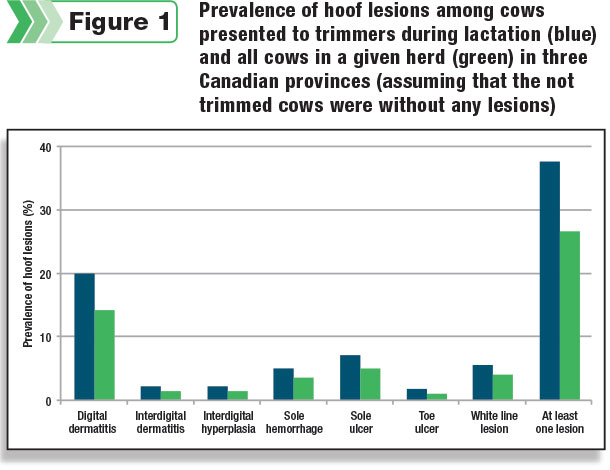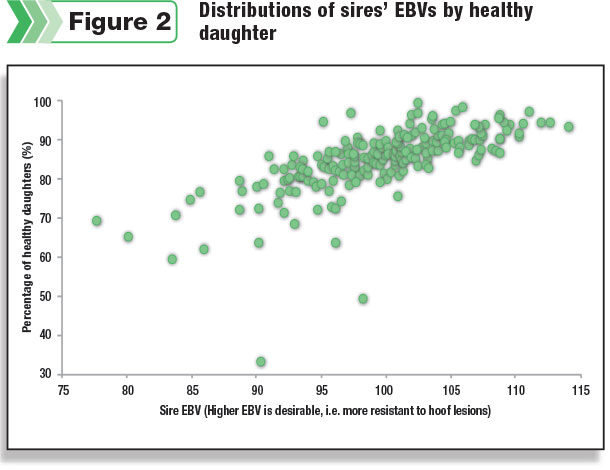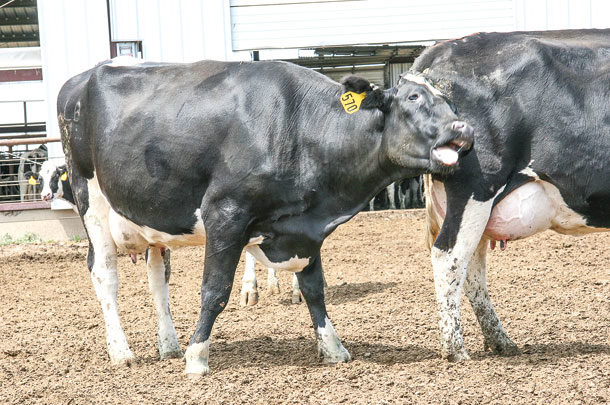Hoof health is a top priority for the Canadian dairy industry right now. An online questionnaire in 2014 revealed lameness is considered the number one health issue by Canadian dairy producers.
The presence of lame cows represents a welfare issue and an economic loss for farmers. The prevalence of cows exhibiting subclinical lameness, or less severe hoof lesions (that do not necessarily cause lameness), is much higher than the prevalence of cows with clinical lameness.
The prevalence of lame cows has been estimated to be between 5 to 7 percent, while studies in Europe and North America reported that 40 to 70 percent of cows in dairy herds suffered from at least one type of hoof lesion.
Data recorded during provincial projects in Alberta, British Columbia and Ontario between 2009 and 2012 revealed almost 40 percent of cows in Canada presented to hoof trimmers had at least one type of hoof lesion.
Because this data came from actual examined cows by hoof trimmers, this prevalence value does not likely reflect the real prevalence of hoof lesions in Canadian herds.
The process for which a cow is presented or not to hoof trimmers is not completely random, as usually cows that show hoof problems have more chances to be presented to hoof trimmers than healthy cows.
The result is: The prevalence of hoof lesions calculated by data recorded directly from hoof trimmers is likely overestimated.
When we consider all of the cows present in a given herd during the trimming period, and we assume the not-trimmed cows were cows without any lesions, the prevalence of cows with at least one lesion drops to around 27 percent (Figure 1), which is still a significantly high prevalence.
 This prevalence may be underestimated because some of the cows that have been considered healthy are perhaps cows with no detected lesions. It is probably fair to say the real prevalence of cows affected by at least one hoof lesion in Canada is a value between 30 and 40 percent.
This prevalence may be underestimated because some of the cows that have been considered healthy are perhaps cows with no detected lesions. It is probably fair to say the real prevalence of cows affected by at least one hoof lesion in Canada is a value between 30 and 40 percent.
Which group of cows should be included in the analyses is not important only when we consider the prevalence of specific lesions but also when we perform a genetic evaluation. An erroneous attribution of the number of affected daughters to a specific sire will affect the estimation of the sire’s breeding value.
The same data has also been used in order to evaluate the possibility of selecting for cows more resistant to hoof lesions.
Management practices play a very important role in the enhancement of hoof health; however, genetic selection can also contribute to decreasing the incidence of hoof lesions. Under the same conditions in a given herd, some cows are more susceptible to develop a lesion, and others are not.
Preliminary results are promising: Despite a low heritability of hoof lesions (0.07), the distribution of the sire estimated breeding values (EBVs) shows significant and exploitable variation among sires.
Higher EBV corresponds to sires with a higher number of healthy daughters (Figure 2). For example, for digital dermatitis (the most common lesion), only 7.4 percent of daughters of the top 10 percent of sires were affected, while 22.7 percent of daughters of the bottom 10 percent of sires were affected.
 The EBVs calculated were also used to evaluate the possibility to use genomic information. Genomic information for these traits can be particularly effective, as it increases significantly the accuracy of breeding values and consequently increases the rate of genetic improvement.
The EBVs calculated were also used to evaluate the possibility to use genomic information. Genomic information for these traits can be particularly effective, as it increases significantly the accuracy of breeding values and consequently increases the rate of genetic improvement.
The results of the genome-wide association study performed on digital dermatitis and sole ulcers were encouraging. Significant peaks were detected on different chromosomes, suggesting the presence of candidate genes in these regions and opening the possibility for using this type of information for the selection of more resistant cows to hoof lesions.
A large research project (part of Dairy Cluster 2) will provide more data to validate these results. The project aims to improve hoof health by developing a data pipeline from hoof trimmers to Canadian DHI databank and to Canadian Dairy Network, and to generate breeding values for sires.
A data collection system that collects reliable data in a univocal and consistent way has been developed. This represents a key step in order to create a national genetic evaluation system.
Canadian hoof trimmers will play an essential role in this process. They will record the data using a software system. The software is available in a French and an English version, and it has been adapted to include the permanent cow identification number and DHI herd number.
The exchange system of files has been already successfully tested in Québec by a pilot group of trimmers and is now ready to be used by other trimmers across Canada.
Genetic evaluation will have a real impact on improving hoof health in dairy herds. Along with good management practices, genetic selection will soon be included in the toolbox available for dairy managers looking for improving hoof health status in their herd. PD
Francesca Malchiodi is with the University of Guelph, Anne-Marie Christen is with Valacta, and Filippo Miglior is with the Canadian Dairy Network.
This project is funded by the Dairy Research Cluster Initiative (Dairy Farmers of Canada, Agriculture and Agri-Food Canada, the Canadian Dairy Network and the Canadian Dairy Commission), the Ontario Genomics Institute and Alberta Milk.
PHOTO: Management practices play a very important role in the enhancement of hoof health; however, genetic selection can also contribute to decreasing the incidence of hoof lesions. Staff photo.







